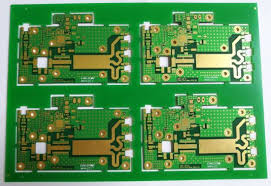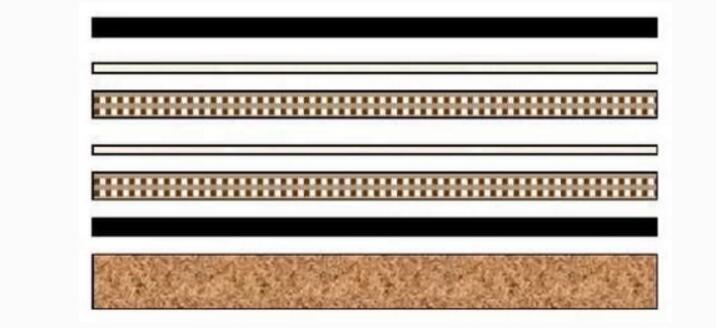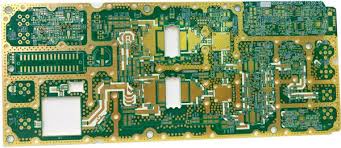Definition of PCB high frequency board
High frequency board refers to a special circuit board with a high electromagnetic frequency. It is used for PCBs in the fields of high frequency (frequency greater than 300MHZ or wavelength less than 1 meter) and microwave (frequency greater than 3GHZ or wavelength less than 0.1 meter). Part of the process on the copper board using ordinary rigid circuit board manufacturing methods or circuit boards produced using special processing methods. Generally speaking, a high-frequency board can be defined as a circuit board with a frequency above 1 GHz.
With the rapid development of science and technology, more and more equipment designs are applied in the microwave frequency band (> 1GHZ) and even in the millimeter wave field (30GHZ). This also means that the frequency is getting higher and higher, Material requirements are also getting higher and higher. For example, the substrate material needs to have excellent electrical properties, good chemical stability, and the loss requirement on the substrate with the increase of the power signal frequency is very small, so the importance of high-frequency sheet materials has become prominent.
Classification of PCB high frequency board
1, ceramic-filled thermosetting material
processing method:
The processing process is similar to that of epoxy resin / glass woven cloth (FR4), except that the plate is relatively brittle and easy to break, and the life of the drill and gong knife is reduced by 20% when drilling and gong plate.
2, PTFE (polytetrafluoroethylene) material
processing method:
1. Opening: Protective film opening must be kept to prevent scratches and indentations
2. Drilling:
2.1 Use a new drill bit (standard 130), the best one by one, the pressure of the presser foot is 40psi
2.2 Aluminum sheet is the cover plate, then use 1mm melamine pad to tighten the PTFE plate
2.3 After drilling, blow out the dust in the hole with an air gun
2.4 Use the most stable drilling rig, the drilling parameters (basically the smaller the hole, the faster the drilling speed, the smaller the chip load, the smaller the return speed)
3. Hole treatment
Plasma treatment or sodium naphthalene activation treatment is good for pore metallization
4.PTH sink copper
4.1 After the micro-etching (the micro-etching rate is controlled by 20 micro-inches), the PTH is pulled into the plate from the degreasing cylinder.
4.2 If necessary, pass the second PTH. The cylinder starts to enter the plate
5. Solder mask
5.1 Pre-treatment: use acid washing plate, do not use mechanical grinding plate
5.2 Pre-treatment screed plate (90 ℃, 30min), solidify with green oil
5.3 Divided into three sections: one section at 80 ℃, 100 ℃, 150 ℃, each time is 30min (if you find that the surface of the substrate is oily, you can rework: wash the green oil and reactivate it)
6. Gong board
Put the white paper on the circuit surface of the PTFE board, and clamp the FR-4 base material board or phenolic bottom board with a thickness of 1.0MM to remove copper:
High-frequency high-speed sheet
When selecting a PCB substrate for a high-frequency circuit, it is necessary to particularly check the change characteristics of the material DK at different frequencies. For requirements that focus on high-speed signal transmission or characteristic impedance control requirements, the focus is on DF and its performance under frequency, temperature, and humidity conditions.
The general substrate material shows great changes in the DK and DF values under conditions of frequency changes. Especially at frequencies from 1 MHz to 1 GHz, the changes in their DK and DF values are more pronounced. For example, the substrate material (general FR-4) of a general epoxy glass fiber cloth substrate (general FR-4) has a DK value of 4.7 at a frequency of 1 MHz and a DK value of 4.19 at a frequency of 1 MHz. 1 GHz frequency. Above 1GHz, the change trend of its DK value is gentle. The changing trend is that it will become smaller as the frequency increases (but the magnitude of the change is not large). For example, at 10 GHz, the DK value of FR-4 is 4.15. The substrate material with high-speed and high-frequency characteristics varies in frequency. In the case of DK, the change in DK value is small. In the frequency of change from 1MHz to 1GHz, DK mainly keeps the change in the range of 0.02. Under different frequency conditions from low to high, the DK value tends to decrease slightly.
When the DF value is affected by a frequency change (especially a change in the high frequency range), the dielectric loss factor (DF) of a common substrate material is greater than DK. Its changing law tends to increase. Therefore, when evaluating the high-frequency characteristics of a substrate material, its research focus is on the change in its DF value. For substrate materials with high-speed and high-frequency characteristics, in terms of changing characteristics at high frequencies, there are two distinct types of common substrate materials: one is that its (DF) value changes little with frequency. . The other type is similar to ordinary substrate materials in terms of magnitude of change, but has a lower value of itself (DF).
How to choose a high-frequency high-speed board
The choice of PCB must strike a balance between meeting design requirements, mass production and cost. In short, design requirements include electrical and structural reliability. This issue is usually more important when designing ultra-high-speed PCB boards (frequency greater than GHz). For example, the currently commonly used FR-4 material has a large dielectric loss Df (dielectric loss) at a frequency of several GHz, and thus may not be applicable.
The 10Gb / S high-speed digital signal is a square wave, which can be regarded as a superposition of sine wave signals of different frequencies. So 10Gb / S contains many different frequency signals: 5Ghz fundamental signal, 3rd order 15GHz, 5th order 25GHz, 7th order 35GHz signal, etc. Maintaining the integrity of the digital signal and the steepness of the upper and lower edges are the same as the low-loss and low-distortion transmission of RF microwave (the high-frequency harmonic part of the digital signal reaches the microwave frequency band). Therefore, in many aspects, the requirements for high-speed digital circuit PCB material selection and RF microwave circuits are similar.
What are the PCB high frequency boards? PCB high frequency board classification
In actual engineering operations, the selection of high-frequency plates seems simple, but there are still many factors to be considered. Through the introduction of this article, as a PCB design engineer or high-speed project leader, have a certain understanding of the characteristics and selection of the plate . Understand the electrical properties, thermal properties, reliability, etc. of the plate. And the reasonable use of lamination, design a product with high reliability and good processability, the consideration of various factors has been optimized.
Introduced separately below, the main considerations in selecting the appropriate plate:
1, manufacturability:
For example, how many times the lamination performance, temperature performance, etc., CAF / heat resistance and mechanical toughness (adhesion) (good reliability), fire rating;
2. Various performances (electrical, performance stability, etc.) that match the product:
Low loss, stable Dk / Df parameters, low dispersion, small coefficient of variation with frequency and environment, small material thickness and glue content tolerance (good impedance control), if the trace is long, consider low-roughness copper foil. In addition, the high-speed circuit design needs simulation in the early stage, and the simulation result is the reference standard for design. "Xingsen Technology-Agilent (High-Speed / RF) Joint Lab" has solved the problem of inconsistent performance between simulation results and tests. It has done a lot of simulation and actual test closed-loop verification. It can achieve simulation and actual measurement consistency through unique methods.
What are the PCB high frequency boards? PCB high frequency board classification
3. Timely availability of materials:
The procurement cycle of many high-frequency boards is very long, even 2-3 months. Except that the conventional high-frequency board RO4350 is in stock, many high-frequency boards need to be provided by customers. Therefore, the high-frequency sheet needs to communicate well with the manufacturer in advance and prepare materials as soon as possible;
4. Cost:
Look at the price sensitivity of the product, whether it is a consumer product or a communication, medical, industrial, military application;
5. Applicability of laws and regulations:
It should be integrated with environmental protection regulations of different countries to meet RoHS and halogen-free requirements.
各个 Among the above factors, the speed of high-speed digital circuits is the main factor for PCB selection. The higher the circuit speed, the smaller the PCBDf value should be. Medium and low-loss circuit boards will be suitable for 10Gb / S digital circuits; plates with lower losses will be suitable for 25Gb / s digital circuits; ultra-low-loss boards will be adapted for faster high-speed digital circuits, and the rate can be 50Gb / s or higher.
From the material Df:
Df is between 0.01 ~ 0.005. Circuit board is suitable for digital circuits with an upper limit of 10Gb / S;
Df is between 0.005 and 0.003. Circuit board is suitable for digital circuits with an upper limit of 25Gb / S;
板材 Df does not exceed 0.0015 for circuit boards suitable for 50Gb / S or even higher speed digital circuits.
Common high-speed plates are:
1), Rogers: RO4003, RO3003, RO4350, RO5880, etc.
2), Tai Yao TUC: Tuc862, 872SLK, 883, 933, etc.
3), Panasonic: Megtron4, Megtron6, etc.
4), Isola: FR408HR, IS620, IS680, etc.
5), Nelco: N4000-13, N4000-13EPSI, etc.
6), Dongguan Shengyi, Taizhou Wangling, Taixing Microwave, etc.
Of course, there are many other high-frequency materials, such as Arlon (acquired by Rogers last year) and Taconic, which are all old-fashioned RF microwave plate factories with guaranteed performance.





